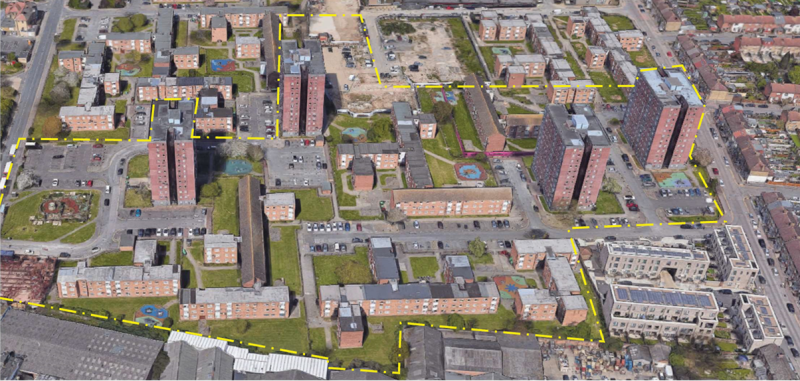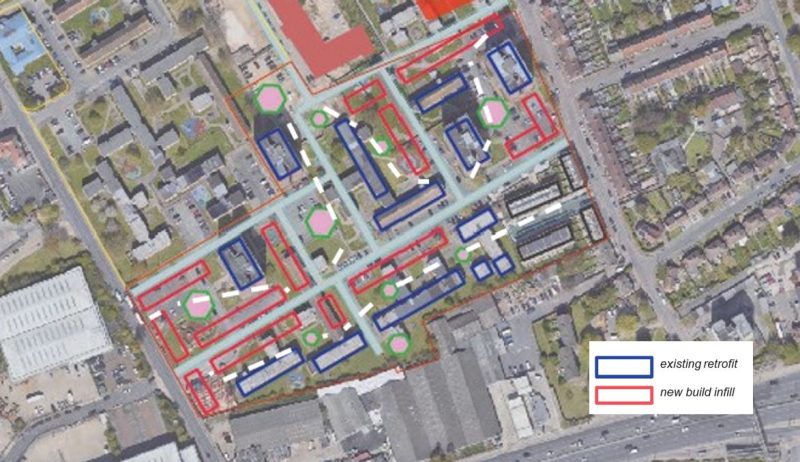Retrofitting the Great Estates
Hosted at Civic Engineers’ riverside studio, this roundtable proposed ways to retrofit great estates more sustainably. A provocation was presented to the table by White Arkitekter’s Linda Thiel and Gareth Atkinson of Civic; after which, the group broke into discussion chaired by Toby Fox of Inner Circle Consulting.
Based on ideas sparked mid-way through the live regeneration project Gascoigne Estate, the two design team consultants presented solutions to the Estate client, Be First. For context, regeneration of the project situated in east London’s Barking was conceived by the council in 2001, starting with Gascoigne East Phase 1 in 2015. As of January 2023, there remains a few phases on Gascoigne East South to complete the wider neighbourhood regeneration.
The design team’s proposal was simple: rather than following the original brief of demolish and rebuild, how could a future phase of the regeneration process be achieved through a retrofit approach?

By assessing the buildings, streets, and physical fabric of the project, White Arkitekter proposed certain spaces were able to be reused as new. Improving the urban fabric and landscape/public realm was an important aspect of the design approach. Civic Engineers then tested the carbon footprint of the proposal, as well as the existing buildings on the sites being worked on. 13,000 tonnes was the estimated amount of embodied carbon in the existing structures remaining in the Gascoigne Estate.
The objective was to maximise which buildings, aspects and shapes could be retained to deliver the brief. And what should be changed. Several options were proposed, based on delivering an additional 575 to 800 homes. See images below for details:

When calculating it by metre squared, the embodied carbon of the retrofit proposal is reduced for the retrofitted buildings by roughly 60%. Timber versions proposed were dropped due to GLA regulations.
Taking into consideration load bearings and playing with aspects such as external balconies, the team was able to increase floor space, add an additional staircase and improve the thermal capacity of the buildings.
The solution provides an additional storey to the existing towers, allowing the creation of green and blue spaces on the roof and increasing biodiversity for the area. With the flats thermally insulated to meet current operational carbon standards adding balconies improves the tenant’s living experience, allowing them access to personalised outside space.
Expanding the thinking beyond just buildings, White Arkitekter proposed a retrofit approach to the landscape sees the embrace of passive urban design approaches which help biodiversity flourish faster. Beyond the estate, the street patterns can be reused and improved, especially with the introduction of SUDs and green roofs, which both slow down rainwater and aren’t expensive to install, nor encroach on the existing infrastructure. These suggestions can offer significant cost savings.
While it’s not clear where the overall construction cost stands compared to demolition and rebuild, the team is seeking input from a Quantity Surveyor to compare. The construction speed is most certainly faster.
Either way, the community and residents’ reception is a critical element. The purpose of any redevelopment is about changing homes for the people who live there for the better.
The table then acknowledged the following challenges within the industry and their own dealings with policy, investor relations, skills and resources as well as timely decision making.
Scale and Cooperation
Over 20 million homes in the UK are ripe for retrofit. The scale of this challenge is, for some operators, in the hundreds of thousands of homes per organisation. Councils and Housing Associations are setting aside hundreds of millions of pounds to handle retrofitting solutions. Getting large associations’ internals teams to talk to each other can be a challenge.
Collaboration and Politics
The conversation has shifted to clients and communities asking for retro first. Where ‘blanket demolition’ proposals were made, now some estates are working with the local community to see what its aspirations are. Charitable foundations are creating templates for what residents want, to inform the investment decisions made for these homes. How tenants feel about their homes, buildings, and blocks impacts what political Members hear which impacts political decisions made.
Communications and Skills
A client’s understanding and resource/skillset can still hinder success as can funding and political constraints. The business case needs to be made for retrofit. A challenge is investing in existing stock while delivering new homes. In redefining what a “new home” is, we could change engrained and often negative cultural attitudes – retrofitting could be conceived as ‘new’. Both challenges need to be reviewed as a whole system, and the government needs to be lobbied to create a budget system that takes these factors into account. The will exists to find opportunities for change, and research should be done around it.
Funding and Investment
Various funds are in place, but the systems are broken. We need to strike the right balance between demolition and retrofit, while delivering the right mix of tenures. The funding landscape doesn’t cover the amount of homes that need to be delivered. Funds can be managed in strategic ways, for example ‘comfort plans’ prevent the residents’ council taxes from going up by taking the money that they would have paid and investing that into improving their homes.
Future First/Forward Facing
Any deep retrofit must fulfil future changes, so it’s a full ‘generational change’. We need a regulatory framework that allows investment with confidence. The private sector has agency to lead where the government has failed – this is being shown in relationship strengthening between local authorities and developers.